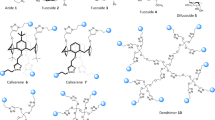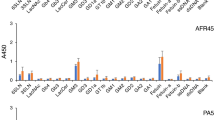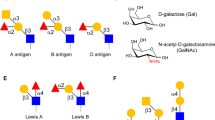Abstract
Anguilla anguilla agglutinin (AAA), a fucolectin found in the serum of European eel, participates in the recognition of bacterial liposaccharides by the animal innate immunity system. Because AAA specifically recognizes fucosylated terminals of H and Lewis (a) blood groups, it has been used extensively as a reagent in blood typing and histochemistry. AAA contains a newly discovered carbohydrate recognition domain present in proteins of organisms ranging from bacteria to vertebrates. The crystal structure of the complex of AAA with a-L-fucose characterizes the novel fold of this entire lectin family, identifying the residues that provide the structural determinants of oligosaccharide specificity. Modification of these residues explains how the different isoforms in serum can provide a diverse pathogen-specific recognition.
This is a preview of subscription content, access via your institution
Access options
Subscribe to this journal
Receive 12 print issues and online access
$189.00 per year
only $15.75 per issue
Buy this article
- Purchase on Springer Link
- Instant access to full article PDF
Prices may be subject to local taxes which are calculated during checkout






Similar content being viewed by others
References
Hoffmann, J.A., Kafatos, F.C., Janeway, C.A. & Ezekowitz, R.A. Phylogenetic perspectives in innate immunity. Science 284, 1313–1318 (1999).
Vasta, G.R., Quesenberry, M., Ahmed, H. & O'Leary, N. C-type lectins and galectins mediate innate and adaptive immune functions: their roles in the complement activation pathway. Dev. Comp. Immunol. 23, 401–420 (1999).
Saito, T., Hatada, M., Iwanaga, S. & Kawabata, S. A newly identified horseshoe crab lectin with binding specificity to O-antigen of bacterial lipopolysaccharides. J. Biol. Chem. 272, 30703–30708 (1997).
Honda, S., Kashiwagi, M., Miyamoto, K., Takei, Y. & Hirose, S. Multiplicity, structures, and endocrine and exocrine natures of eel fucose-binding lectins. J. Biol. Chem. 275, 33151–33157 (2000).
Springer, G.F. & Desai, P.R. Monosaccharides as specific precipitinogens of eel anti-human blood-group H(O) antibody. Biochemistry 10, 3749–3761 (1971).
Baldus, S.E. et al. Characterization of the binding specificity of Anguilla anguilla agglutinin (AAA) in comparison to Ulex europaeus agglutinin I (UEA-I). Glycoconj. J. 13, 585–590 (1996).
Morgan, W.T. & Watkins, W.M. Unravelling the biochemical basis of blood group ABO and Lewis antigenic specificity. Glycoconj. J. 17, 501–530 (2000).
Macedo-Ribeiro, S. et al. Crystal structures of the membrane-binding C2 domain of human coagulation factor V. Nature 402, 434–439 (1999).
Ito, N. et al. Novel thioether bond revealed by a 1.7 Å crystal structure of galactose oxidase. Nature 350, 87–90 (1991).
Gaskell, A., Crennell, S. & Taylor, G. The three domains of a bacterial sialidase: a β-propeller, an immunoglobulin module and a galactose-binding jelly-roll. Structure 3, 1197–1205 (1995).
Wendt, K.S. et al. Crystal structure of the APC10/DOC1 subunit of the human anaphase-promoting complex. Nature Struct. Biol. 8, 784–788 (2001).
Marintchev, A. et al. Solution structure of the single-strand break repair protein XRCC1 N-terminal domain. Nature Struct. Biol. 6, 884–893 (1999).
Kairies, N. et al. The 2.0 Å crystal structure of tachylectin 5A provides evidence for the common origin of the innate immunity and the blood coagulation systems. Proc. Natl. Acad. Sci. USA 98, 13519–13524 (2001).
Rudd, P.M., Elliott, T., Cresswell, P., Wilson, I.A. & Dwek, R.A. Glycosylation and the immune system. Science 291, 2370–2376 (2001).
Bezkorovainy, A., Springer, G.F. & Desai, P.R. Physicochemical properties of the eel anti-human blood-group H(O) antibody. Biochemistry 10, 3761–3764 (1971).
Kelly, C. Physicochemical properties and N-terminal sequence of eel lectin. Biochem. J. 220, 221–226 (1984).
Pierschbacher, M.D., Hayman, E.G. & Ruoslahti, E. The cell attachment determinant in fibronectin. J. Cell. Biochem. 28, 115–126 (1985).
Springer, G.F. & Desai, P.R. The immunochemical requirement for specific activity and the physiological properties of eel anti-human blood-group H(O) 7 S Globulin. Vox Sang. 18, 551–554 (1970).
Imberty, A. Oligosaccharide structures: theory versus experiment. Curr. Opin. Struct. Biol. 7, 617–623 (1997).
Imberty, A. et al. Computer simulation of histo-blood group oligosaccharides: energy maps of all constituting disaccharides and potential energy surfaces of 14 ABH and Lewis carbohydrate antigens. Glycoconj. J. 12, 331–349 (1995).
Bush, C.A., Martin-Pastor, M. & Imberty, A. Structure and conformation of complex carbohydrates of glycoproteins, glycolipids, and bacterial polysaccharides. Annu. Rev. Biophys. Biomol. Struct. 28, 269–293 (1999).
Perez, S. et al. Crystal and molecular structure of a histo-blood group antigen involved in cell adhesion: the Lewis x trisaccharide. Glycobiology 6, 537–542 (1996).
Rini, J.M. & Lobsanov, Y.D. New animal lectin structures. Curr. Opin. Struct. Biol. 9, 578–584 (1999).
Holm, L. & Sander, C. Protein structure comparison by alignment of distance matrices. J. Mol. Biol. 233, 123–138 (1993).
Tettelin, H. et al. Complete genome sequence of a virulent isolate of Streptococcus pneumoniae. Science 293, 498–506 (2001).
Adams, M.D. et al. The genome sequence of Drosophila melanogaster. Science 287, 2185–2195 (2000).
Seery, L.T., Schoenberg, D.R., Barbaux, S., Sharp, P.M. & Whitehead, A.S. Identification of a novel member of the pentraxin family in Xenopus laevis. Proc. R. Soc. Lond. B Biol. Sci. 253, 263–270 (1993).
Meindl, A. et al. A gene (SRPX) encoding a sushi-repeat-containing protein is deleted in patients with X-linked retinitis pigmentosa. Hum. Mol. Genet. 4, 2339–2346. (1995).
Horejsi, V. & Kocourek, J. Studies on lectins. XXXVI. Properties of some lectins prepared by affinity chromatography on O-glycosyl polyacrylamide gels. Biochim. Biophys. Acta 538, 299–315 (1978).
Dodd, R.B. & Drickamer, K. Lectin-like proteins in model organisms: implications for evolution of carbohydrate-binding activity. Glycobiology 11, 71R–79R (2001).
Zhang, H. et al. Crystal structure of YbaK protein from Haemophilus influenzae (HI1434) at 1.8 Å resolution: functional implications. Proteins 40, 86–97 (2000).
Saukkonen, K., Burnette, W.N., Mar, V.L., Masure, H.R. & Tuomanen, E.I. Pertussis toxin has eukaryotic-like carbohydrate recognition domains. Proc. Natl. Acad. Sci. USA 89, 118–122 (1992).
Baumgartner, S., Hofmann, K., Chiquet-Ehrismann, R. & Bucher, P. The discoidin domain family revisited: new members from prokaryotes and a homology-based fold prediction. Protein Sci. 7, 1626–1631 (1998).
Vogel, W. Discoidin domain receptors: structural relations and functional implications. FASEB J. 13, S77–S82 (1999).
Poole, S., Firtel, R.A., Lamar, E. & Rowekamp, W. Sequence and expression of the discoidin I gene family in Dictyostelium discoideum. J. Mol. Biol. 153, 273–289 (1981).
Weis, W.I., Drickamer, K. & Hendrickson, W.A. Structure of a C-type mannose-binding protein complexed with an oligosaccharide. Nature 360, 127–134 (1992).
Collaborative Computational Project, Number 4. The CCP4 suite: programs for protein crystallography. Acta Crystallogr. D 50, 760–763 (1994).
Jones, T.A., Zou, J.Y., Cowan, S.W. & Kjeldgaard, M. Improved methods for building protein models in electron density maps and the location of errors in these models. Acta Crystallogr. A 47, 110–119 (1991).
Brünger, A. et al. Crystallography & NMR system: a new software suite for macromolecular structure determination. Acta Crystallogr. D 54, 905–921 (1998).
Altschul, S.F. et al. Gapped BLAST and PSI-BLAST: a new generation of protein database search programs. Nucleic Acids Res. 25, 3389–402 (1997).
Esnouf, R.M. Further additions to MolScript version 1.4, including reading and contouring of electron density maps. Acta Crystallogr. D 55, 938–940 (1999).
Merrit, E.A. & Bacon, D.J. RASTER3D Methods Enzymol. 277, 505–524 (1997).
Nicholls, A., Sharp, K. & Honig, B. Protein folding and association: insights from the interfacial and thermodynamic properties of hydrocarbons. Proteins Struct. Func. Genet. 11, 281–286 (1991).
Gouet, P., Courcelle, E., Stuart, D.I. & Metoz, F. ESPript: analysis of multiple sequence alignments in PostScript. Bioinformatics 15, 305–308 (1999).
Acknowledgements
We thank D. Leahy and G. Hart for critical reviewing of the manuscript. This research is supported by a grant from National Institute of General Medical Sciences to L.M.A. and a grant from the National Science Foundation to G.R.V.
Author information
Authors and Affiliations
Corresponding authors
Ethics declarations
Competing interests
The authors declare no competing financial interests.
Rights and permissions
About this article
Cite this article
Bianchet, M., Odom, E., Vasta, G. et al. A novel fucose recognition fold involved in innate immunity. Nat Struct Mol Biol 9, 628–634 (2002). https://doi.org/10.1038/nsb817
Received:
Accepted:
Published:
Issue Date:
DOI: https://doi.org/10.1038/nsb817
This article is cited by
-
YesU from Bacillus subtilis preferentially binds fucosylated glycans
Scientific Reports (2018)
-
Transcriptomic Profiling of Egg Quality in Sea Bass (Dicentrarchus labrax) Sheds Light on Genes Involved in Ubiquitination and Translation
Marine Biotechnology (2017)



